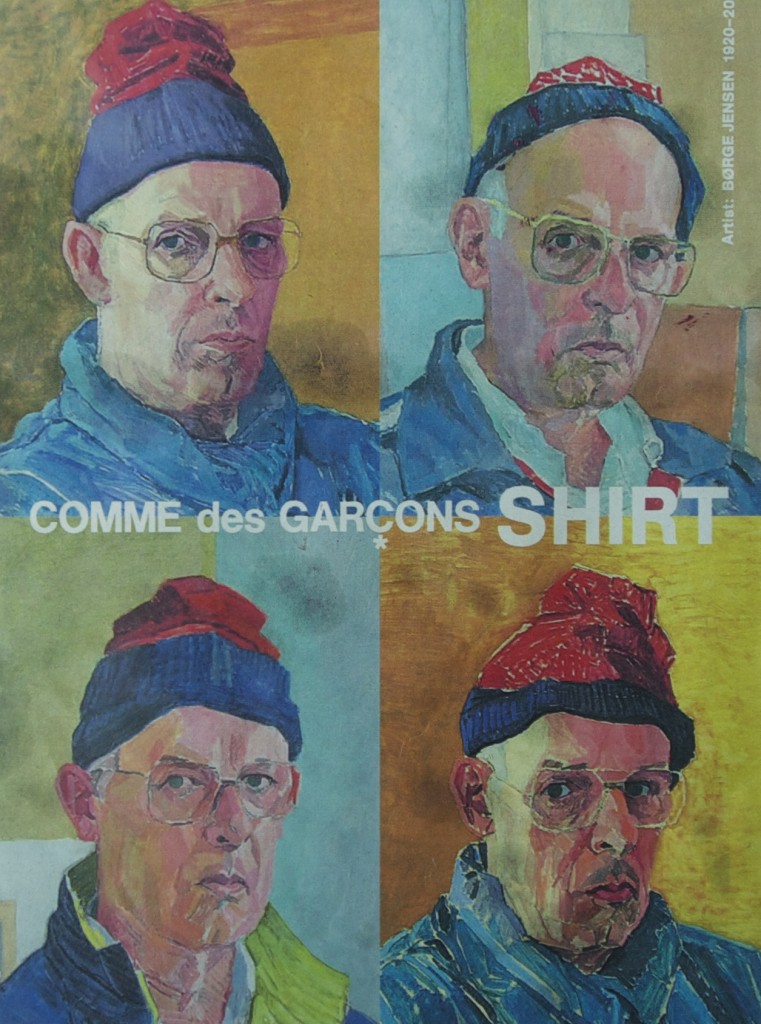Due to excessive modesty . . .
A few days ago, I came across a clipping I found, if I remember properly, in the Sunday Times magazine, about four years ago. It’s an ad for a fashion site that baffles me (click to it and figure it out at your leisure), but I was so impressed with the paintings in this ad, I cut it out and saved it. It shows a grid of oil self-portraits, in the manner of Warhol—same pose, same face, same hat, over and over, stacked and aligned like window panes. And yet that’s where the uniformity disappears. Where Warhol would have simply reprinted the same photograph, over and over, but used as a template for different colors, this artist had painstakingly repainted his own face, wearing the same colorful stocking cap, but using different colors, with different backgrounds, different jackets, differentiating each one to the point where it was almost entirely original in comparison with all the others. And you get the same sense of repetition, mass production, but he’s reversed the tension, emphasizing the originality, stressing how much manual labor went into this repetitive act of portraiture, with the hint of mass production an almost sardonic glance back at the intentional emptiness of Pop. I love these paintings, nearly Fauvist, but closer to actual effects of light, with an emphasis on color for its own sake, even though the faces convey exactly what portraits should: a complex inner life, and the evidence of a life lived in a unique way.
Here’s what pleases me most about this image, now that I’ve accidentally stumbled upon it in my studio. These paintings are by a virtually unknown Danish artist, who died in 2008, a year before this ad appeared. His name is Borge Jensen. If you try searching for anything about him on the Web, you eventually come across two websites that reproduce the ad I’ve got in paper form, but mostly your search engine tries to correct your spelling or takes you to links about other people entirely. If you are lucky, and try enough combinations of his name with the words “artist” or “painting” you may get to this link at lauritz.com. Twice when I clicked to it, a paragraph appeared which was, in Danish, a summary of the painter’s life, but whenever I click now, it redirects me to an error page. It’s as if even the Internet wants to keep this guy unknown. I’m not sure he would mind, frankly. One of the times my browser managed to get a purchase on that site and stay on it, I had Google translate it, and this is what I got:
Børge Jensen was a painter, draftsman and printmaker – has worked with landscapes, still lifes, portraits and self-portraits. Born and raised in Strib at the Little Belt. After being trained as a painter with his father he sought in the early 1940s to Copenhagen. To prepare for the Academy of Fine Arts, he began at the Academy of Free and Commercial Art at Jarmers place by the painter Askov Jensen and cartoonist Tom Petersen (6 winters).Next, he applied for admission to the Academy in 1946 and was assumed to begin painting school with Professor Aksel Jørgensen in January 1947. Was taught one semester of Vilhelm Lundstrom and followed the teaching of Painting School and the School of Graphic forward to 1955. While such Maria Lüders Hansen (b. 1925) and Knud Bjerre (1921-2005).Study tours and exhibitions have – due to an excessive modesty – only shown a few times, including Strib Idrætsefterskole 1994 and Strib Sognegård “Paintings tells the story” 1996. Attended School trips include to Florence in 1950. stations’ statements Børge Jensen landscapes, still lifes, portraits and especially self-portraits show the artist’s constant search around reflex candles importance and his immersion in the study of mass displacements in space and scale. More photos could call to mind Edvard Weie and Karl Isaksons color.
Wish I knew what “reflex candles” actually meant, in Danish. It’s almost like finding a message in a bottle, tossed into the Baltic, washing up years later on the shore of Lake Ontario. There’s actually almost no information even in this quick bio, but this one passage stood out: “Due to excessive modesty, has only shown a few times . . .” What could be more anti-Warhol? What could be more encouraging and inspiring. To do such great work and rarely seek any attention for it . . . what a tonic for this era.

Comments are currently closed.